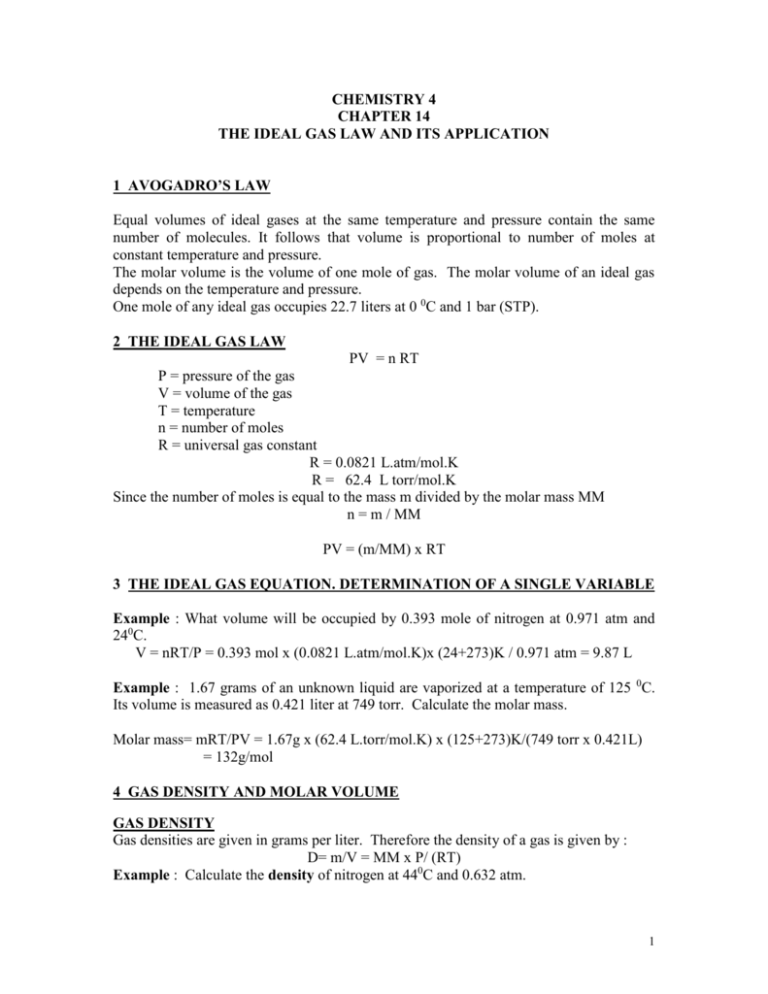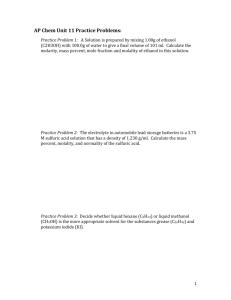gas density - El Camino College
advertisement

CHEMISTRY 4 CHAPTER 14 THE IDEAL GAS LAW AND ITS APPLICATION 1 AVOGADRO’S LAW Equal volumes of ideal gases at the same temperature and pressure contain the same number of molecules. It follows that volume is proportional to number of moles at constant temperature and pressure. The molar volume is the volume of one mole of gas. The molar volume of an ideal gas depends on the temperature and pressure. One mole of any ideal gas occupies 22.7 liters at 0 0C and 1 bar (STP). 2 THE IDEAL GAS LAW PV = n RT P = pressure of the gas V = volume of the gas T = temperature n = number of moles R = universal gas constant R = 0.0821 L.atm/mol.K R = 62.4 L torr/mol.K Since the number of moles is equal to the mass m divided by the molar mass MM n = m / MM PV = (m/MM) x RT 3 THE IDEAL GAS EQUATION. DETERMINATION OF A SINGLE VARIABLE Example : What volume will be occupied by 0.393 mole of nitrogen at 0.971 atm and 240C. V = nRT/P = 0.393 mol x (0.0821 L.atm/mol.K)x (24+273)K / 0.971 atm = 9.87 L Example : 1.67 grams of an unknown liquid are vaporized at a temperature of 125 0C. Its volume is measured as 0.421 liter at 749 torr. Calculate the molar mass. Molar mass= mRT/PV = 1.67g x (62.4 L.torr/mol.K) x (125+273)K/(749 torr x 0.421L) = 132g/mol 4 GAS DENSITY AND MOLAR VOLUME GAS DENSITY Gas densities are given in grams per liter. Therefore the density of a gas is given by : D= m/V = MM x P/ (RT) Example : Calculate the density of nitrogen at 440C and 0.632 atm. 1 D= MMx P / (RT) = (28.02 g/mol) x 0.632 atm/ (( 0.0821 L.atm/mol.K) x (44 + 273)K ) = = 0.680 g/L Example Find the molar mass of an unknown gas if its density is 3.97g/L at 1250C and 749 torr. Molar mass= d x RT/P = (3.97g/L) x (62.4 L.torr/mol.K) x (125+273)K/(749 torr) = 132g/mol MOLAR VOLUME: Molar volume (MV) is the volume occupied by one mole of gas Molar volume = MV ≡ V/n = RT/P Molar volume depends on temperature and pressure Example Find the molar volume of a gas at 80C and 0.568 atm Molar volume = RT/P = (0.0821 L atm/mol. K) x ( 8 + 273) / 0.568 atm = 40.6 L/mol 5 GAS STOICHIOMETRY AT STANDARD TEMPERATURE AND PRESSURE The conversion between volume and mole is by molar volume. Remember that molar volume at standard temperature and pressure is 22.7 L/mol . Example: What volume of hydrogen, measured at STP can be released by 42.7 g Zn as its reacts with hydrochloric acid? Zn (s) + 2 HCl H2 (g) + Zn Cl2 Given 42.7 g Zn Wanted Volume of hydrogen Path mass Zn mol Zn mol of hydrogen volume of hydrogen 42.7 g Zn x ( 1 mol Zn/ 65.38 g Zn ) x (1 mol H2 / 1 mol Zn ) x ( 22.7 L H2 / 1 mol H2 ) = = 14.8 L H2 6 GAS STOICHIOMETRY:MOLAR VOLUME METHOD Example: What volume of hydrogen, measured at 739 torr and 210C can be released by 42.7 g Zn as its reacts with hydrochloric acid? Zn (s) + 2 HCl -------> H2 (g) + Zn Cl2 Factors : To change from volume of hydrogen to mol of hydrogen we need molar volume Molar volume = RT/P = (62.4 L torr/mol.K) x ( 21 + 273) / 739 torr = 24.8 L/mol Path mass Zn --> mol Zn ----> mol of hydrogen ----> volume of hydrogen 42.7 g Zn x ( 1 mol Zn/ 65.4 g Zn ) x (1 mol H2 / 1 mol Zn ) x ( 24.8 L H2 / 1 mol H2 ) = = 16.2 L H2 Example How many liters of CO2 measured at 744 torr and 1310C , will be produced by the complete burning of 16.2 grams of gaseous butane, C4H10? The equation is 2 C4H10 + 13 O2 ------> 10 H2O + 8 CO2 2 Molar volume = RT/P = (62.4 L torr/mol. K) x ( 131 + 273) / 744 torr = 33.9 L/mol The path is gram of C4H10 ---> mol C4H10 ---> mol CO2 -----> L CO2 Calculation: 16.2 gram of C4H10 x (1 mol.C4H10/ 58.12 g C4H10 ) x (8 mol.CO2/ 2 mol.C4H10 ) x (33.9 L CO2 / mol. CO2) = 37.8 L CO2 7 VOLUME-VOLUME GAS STOICHIOMETRY At constant temperature and pressure, the gas volume is directly proportional to number of moles. This means that at the same temperature and pressure the ratio of gas volumes is equal to moles ratio. Example: How many liters of ammonia can be produced by the reaction N2 + 3H2 --------> 2NH3 if the reaction uses 5 L N2 , measured at STP. Since volumes of nitrogen and ammonia are measured at the same temperature and pressure, the ratio of volumes of gases is equal to the ratio of moles of gas determined from the coefficients in the reaction.. 5 L of N2 x (2 L of NH3 / 1 L of N2 ) = 10 L of NH3 Example It is found that 1.75 L of oxygen, measured at 24 0C and 755 torr, is used in burning sulfur. The sulfur dioxide produced is at 165 0C and 785 torr. Find the volume of sulfur dioxide at those condition. O2 + S --------> SO2 First calculate the volume of oxygen at 165 0C and 785 torr as follows Volume of O2 at 165 0C and 785 torr = 1.75 L x ( 755 torr/785 torr) x ( 438 K / 297 K) = 2.48 L O2 Next calculate the volume of sulfur dioxide from the volume of oxygen using the coefficients from the equation : Volume of SO2 (165 0C , 785 torr) = (Volume of O2 (165 0C, 785 torr) x (1L SO2/1 L O2 ) = 2.48 L of O2 x (1L of SO2/1 L of O2 ) = 2.48 L of SO2 3







